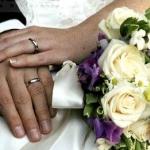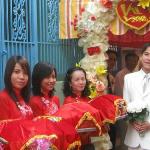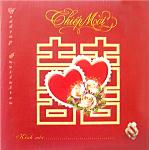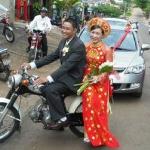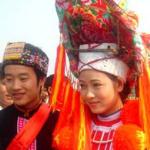TRADITIONAL VIETNAMESE WEDDING
The traditional Vietnamese wedding is one of the most important ceremonies in Vietnamese culture, with influence from Confucian and Buddhist ideologies.
Traditional wedding clothes since the Nguyen dynasty
While traditional clothes of Vietnam have always been very diverse depending on the era and occasion, it is known that after the Nguyen dynasty, copy at www.vietnambiketours.com, women began to wear elaborate Áo dài for their weddings which were modelled on the Áo mệnh phụ (royal Áo dài) of Nguyen dynasty court ladies. The style of the Nguyen dynasty has remained popular and is still used for modern weddings. The difference of the Áo mệnh phụ from the typical Áo dài is the elaborateness of its design (usually embroidered with imperial symbols such as the phoenix) and the extravagant outer cloak. With this gown which is preferably in red or pink, the bride usually wears a Khăn đống headdress. The groom wears a simpler male equivalent, often in blue.
Previous to the Nguyen dynasty, it is likely that women simply wore fancy, elaborate versions of Áo tứ thân.
Engagement
Besides the wedding ceremony, there is also an engagement ceremony which takes place usually half a year or so before the wedding. In the past, most marriages were arranged by the parents or extended family, and while children were sometimes consulted, copy at www.vietnambiketours.com, it was almost always the parents' final decision. While this has changed completely in modern Vietnam, in the past it was not surprising to find that a bride and groom had only just met on the day of their engagement or marriage.
The wedding
The traditional Vietnamese wedding consists of an extensive array of ceremonies: the first is the ceremony to ask permission to receive the bride (abandoned in modern Vietnam), the second is the procession to receive the bride (along with the ancestor ceremony at her house), the third is to bring the bride to the groom's house for another ancestor ceremony and to welcome her into the family, then finally the banquet party.
Due to the spiritual nature of the occasion, the date and time of the marriage ceremony is decided in advance by a Buddhist monk, Spiritual leader, or fortune teller.
Asking permission to "receive" the bride
In the past, on the wedding day the groom's mother (along with a few other close relatives) would make a trip to the bride's home, carrying along a gift of betel. copy at www.vietnambiketours.com, The mother would officially ask permission to "receive" the bride and then notifies the family of the time the procession would arrive to bring the bride to her new home. It was at this time that the bride's family would confirm the state of things and proceedings would take place.
In actuality, this now obsolete ceremony was used in the past to confirm at the last minute that the marriage would even take place. Due to often forced arranged marriages, the bride sometimes fled beforehand and so this ceremony was essential in confirming that things were going smoothly.
In modern Vietnam where people choose their own marriage partners based on love and individual needs, this ceremony is chosen upon the couple whether to go through the process or not.
Receiving the bride
The Procession and gifts
The procession of the groom’s family is led by specific order; usually the first person will be a man chosen as the representative of the groom's house (he should have a good manner of speaking along with high status in society), followed by the groom's father, the groom, then the rest of his immediate family and close friends. Huge traditional umbrellas are carried and accompany the front of the procession. Interestingly, in the past the groom's mother did not take part in the procession as a sign that she would not be a threat to the future bride (and she would even hide for a short period upon the bride's welcome into the groom's home). copy at www.vietnambiketours.com, However, this practice has long been abandoned. The number of people participating in a procession varies but is usually restricted to a smaller number (20 or so) to make it easier on the bride's family who will be receiving all of the guests.
In the procession, the groom and his family (among others) will be bearing elaborately decorated lacquer boxes, covered in red cloth. Inside these boxes are gifts representing the wealth the groom's family will bring to the bride's family. copy at www.vietnambiketours.com, Gifts include: betel, wine, tea, fruit, cakes, a roast pig, and an abundance of jewelry for the bride (the amount of jewelry depending on the personal wealth of the groom's family). Usually the number of gift boxes varies from 6 or 8, but never 7 or 9 which is seen as bad luck.
Upon arriving at the bride's home, firecrackers are lit to alert the bride's family, who then light their own round of firecrackers to welcome the groom's family into their home. After each gift of food is accepted by the bride's parents, the groom then receives permission to greet the bride, who is finally brought out.
Asking permission of the bride's ancestors
The ceremony begins in front of the ancestor altar in the bride’s home. The bride and groom will kneel down in front of the altar and burn incense sticks, copy at www.vietnambiketours.com, asking permission from the bride's ancestors to bless their marriage and their future family. Afterwards, the couple will turn and bow to their parents giving thanks for raising and protecting them. The bride and groom will then bow to each other.
Tea, candle ceremony and speeches
While tea has always been an essential part of Vietnamese life, for commoners Vietnamese tea culture never became as complex or bogged down with rituals as its counterparts in Japan or China. Nevertheless, a traditional wedding is about the only time in a Vietnamese person's life that a formal tea ceremony is essential.
The bride and groom in front of all their family and friends will serve tea (or wine) to their parents. Each parent will then give advice about marriage and family to the couple. copy at www.vietnambiketours.com, A candle ceremony will follow, symbolizing the joining of the bride and groom and their families. The gift boxes filled with jewelry that were brought by the groom's family will be opened by the groom’s mother who will then put each piece on the bride for good fortune.
Due to western influence in the concept of wedding rings, in modern weddings what usually follows is the exchanging of wedding bands (however Catholic Vietnamese families save this for the separate church ceremony).
The bride and groom will then be presented with small red envelopes containing money from close family members. Finally, the groom officially asks to bring the bride to his home, and she follows with the procession to the groom's house.
The ceremony at the groom's home
As the procession arrives back at the groom's house, the groom's family members that had stayed behind will light firecrackers in celebration. The newlyweds will be brought by the groom's parents to their own ancestor altar, where another ancestor ceremony takes place and the bride is introduced to her new relatives. Finally, bride is then brought into what is to be the couple's room and introduced to their new marriage bed.
The banquet party
Following the ceremony at the groom's house, all of the bride and groom's family and friends are invited to a massive banquet party. However, nowadays the order of these ceremonies are slightly rearranged and usually (especially in big cities) the banquet takes place right after the ceremony at the bride's house, with the bride being brought to the groom's house only afterwards.
The number of guests in attendance at these banquets are huge, usually in the hundreds. Elaborate 7-10 course meals are served, with popular dishes including seafood hotpot, the Vietnamese seven courses of beef, and so on so forth. copy at www.vietnambiketours.com, Guests are expected to bring gifts, often money, which the groom and bride at one point in the banquet will go from table to table collecting. Occasionally, the newlyweds may profit from the monetary gifts from their family and guests even after they have paid for their lavish and expensive feasts or reception.
In modern weddings, brides usually change into 3 different gowns during the wedding banquet, 2 of which include the western white wedding gown and once again into the traditional Áo dài she had worn for the previous ceremonies.
Modern compromises and differences in religion
While most Vietnamese are Mahayana Buddhists, a significant minority are Catholic, which actually does not change much about most traditional Vietnamese weddings, whether celebrated in Vietnam or overseas. copy at www.vietnambiketours.com, This is explained because since most Vietnamese practice ancestor worship regardless of denomination; even Catholic Vietnamese have no qualms about the ceremonies traditionally performed at both the bride and groom's house. However, before the banquet, Buddhist families usually visit a temple whereas Catholic families will attend the typical western ceremony at a church.
Most Vietnamese weddings even these days incorporate both eastern and western traditions; one such compromise is the bride wearing both a western gown and an Áo dài throughout the day.
Symbols
Traditional and modern symbols of marriage are often featured during Vietnamese marriage ceremonies as decorations on the wedding umbrellas, lacquer gift boxes (or the red cloth that covers them), or even the decorations in the homes of both the bride and groom. They usually include lanterns, doves, initials of the couple, so on so forth. copy at www.vietnambiketours.com, However one symbol that is indispensable are the words "song hỷ" (also written as the character 囍). Vietnamese was written formerly in Chinese characters as well as the vernacular Chinese influenced Nom script before the 20th century, and while literacy in these scripts during feudalistic times was restricted mostly to scholars, officials and other members of the elite, characters such as these have always played an aesthetic role on important occasions such as weddings.
